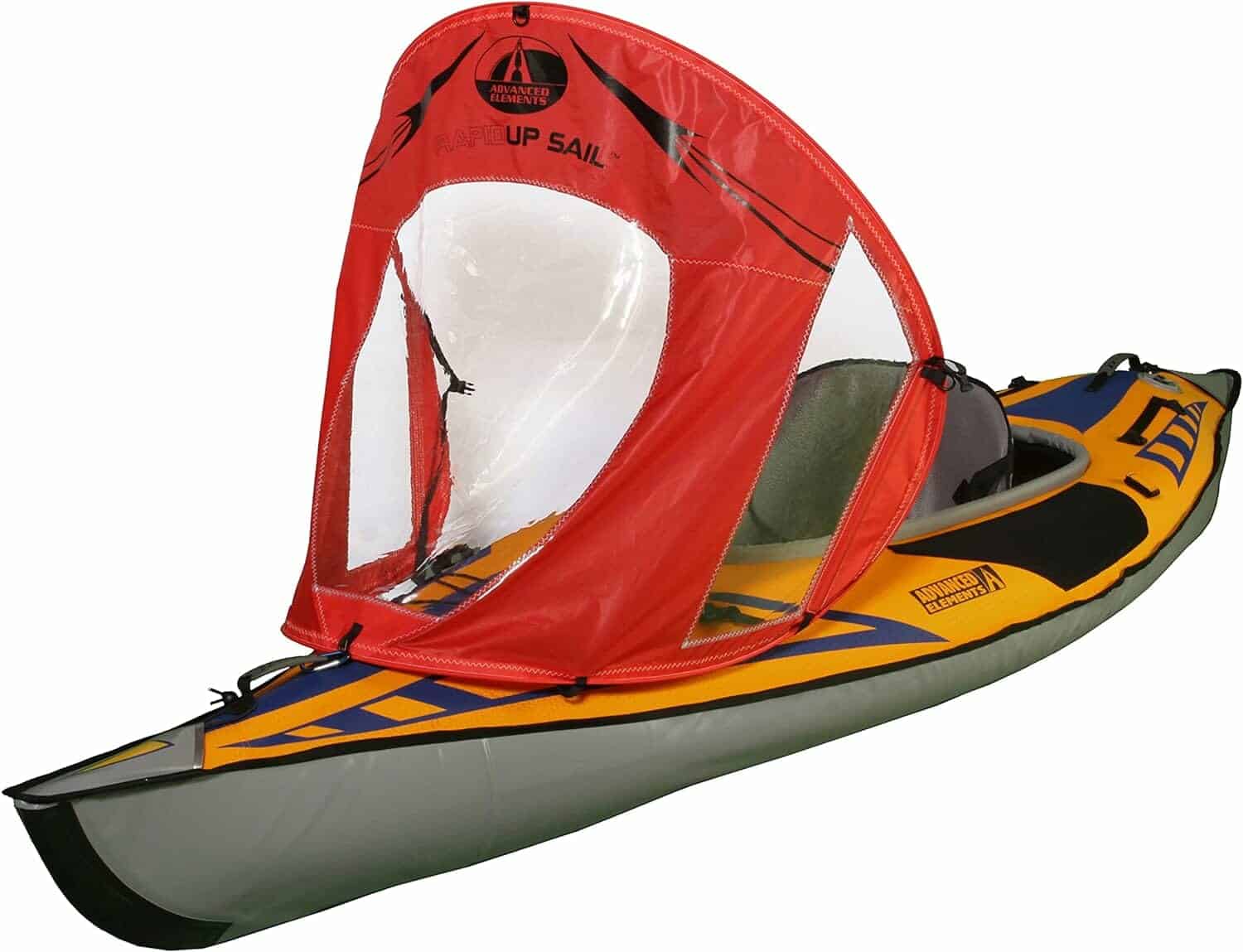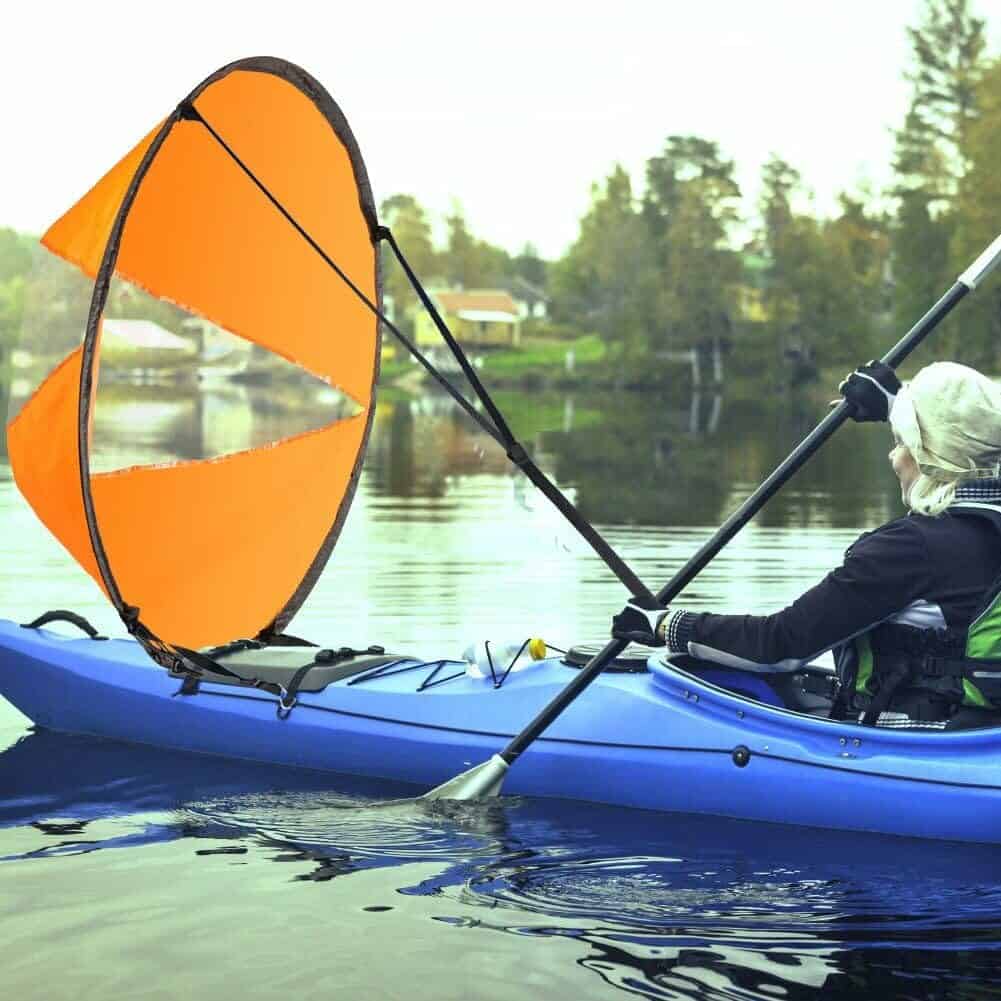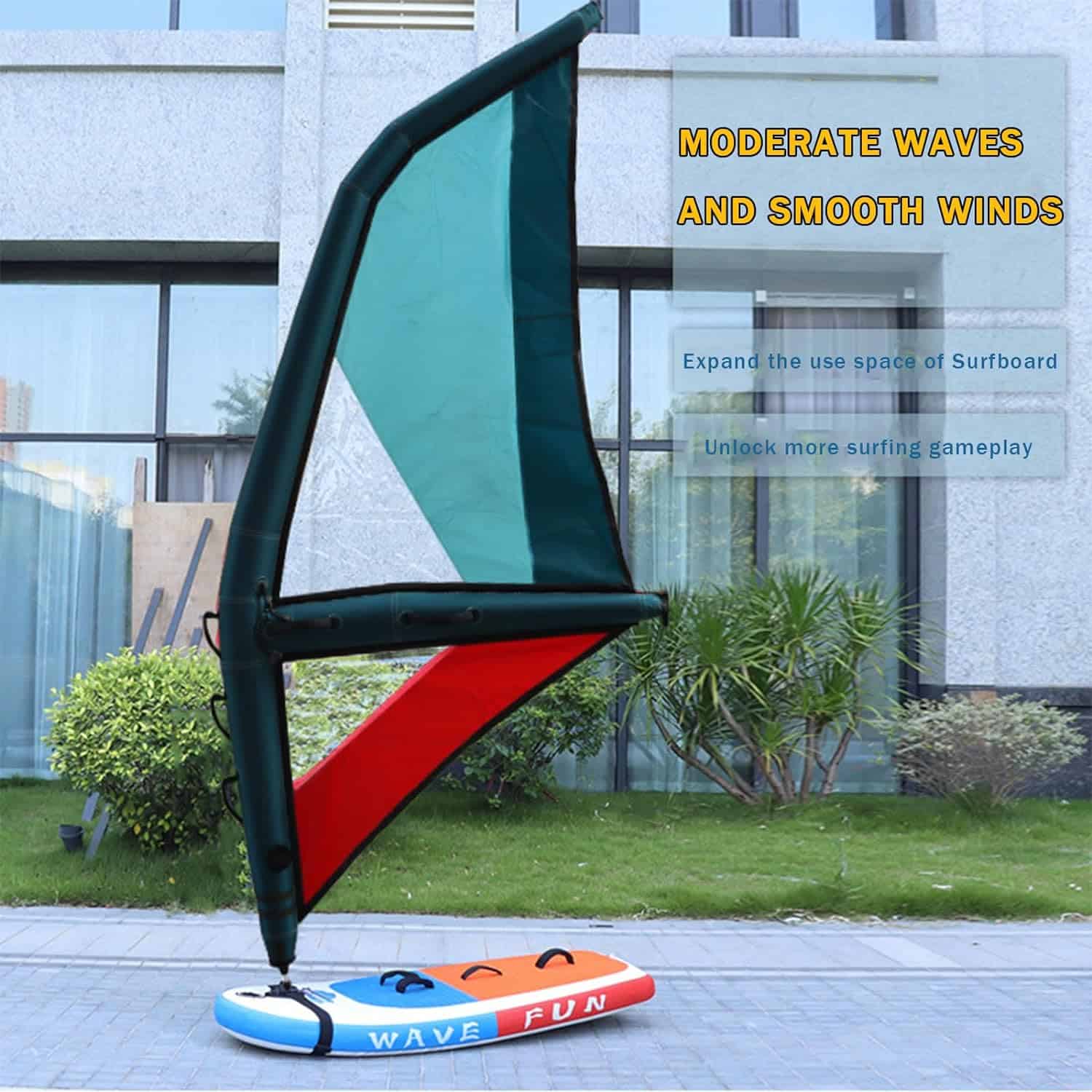Kayaking, a water activity loved for its peacefulness and connection, to the world has undergone changes since its ancient origins. Initially used by the Inuit people for hunting kayaks were made from driftwood or whalebone. Covered with stretched seal skin. As time passed and recreational interests grew kayaks began to evolve with materials and designs. One notable innovation was the integration of sails combining the worlds of sailing and kayaking.
Kayak sailing, a fusion of practices offers enthusiasts a way to enhance their adventures on the water. No longer solely reliant on paddling power kayakers now utilize the wind to increase their speed and explore distances. The benefits of using a sail go beyond speed and range. It adds an element of excitement creates a sense of harmony with nature and allows for journeys, with less fatigue. As we delve deeper into the realm of kayak sails we will discover how they have transformed the kayaking experience and brought advantages to this activity.
Why Consider a Kayak Sail?
The open waters have an appeal with the sound of the paddle cutting through the waves and the peacefulness of a kayak adventure. When you introduce a sail, to this serene setting it takes the experience to another level, in many remarkable ways.
Enhanced Speed and Efficiency
One of the advantages of equipping your kayak with a sail is the increase, in speed. With the wind assisting you you can effortlessly glide through the water at a pace transforming a paddling experience into a smooth sailing adventure. This not adds an exhilarating element, to your journey. Also enables you to navigate through waterways more effectively.
Expanding Horizons
A kayak equipped with a sail allows you to explore areas. This means you can venture into territories uncover coves and truly experience the vastness of the water. In essence it expands your playground to include not the lake, river or sea but a wider world.
A Break from Paddling
Experienced kayakers can confirm the exhaustion that comes with expeditions. Having a sail provides a break, from paddling enabling you to save energy. It’s a chance to take a seat unwind and let the wind lend a hand. This not lessens the effort but also guarantees that you stay invigorated and attentive, throughout your journey.
Adding a sail to your kayaking equipment may appear unconventional, at first. It represents a progression that offers experiences, broader explorations and an extra dash of excitement propelled by the wind.
Factors to Consider When Choosing a Kayak Sail
Have you ever considered attaching a sail, to your kayak? It can completely transform your experience! However before you jump into it there are a factors you should think about to make sure you have the possible sailing adventure. Here is a brief guide to assist you in selecting the sail
Size and Shape
Consider the size and shape of the sail with regards, to your comfort and the type of waters you plan to navigate. Larger sails have the advantage of capturing wind for speed but they can also be more challenging to handle. Additionally the design, whether triangular or otherwise will impact how you maneuver along with the wind. It is important to choose a sail that aligns with your style of adventure.
Material
Have you ever experienced something losing its color or quality after being exposed to the sun for long? The same thing can happen to a sail. It’s important to choose materials that’re both durable and lightweight while also ensuring they offer protection, against UV rays. All a sail is designed to harness the power of the sun (and wind) isn’t it?
Mounting & Compatibility
Lets make sure we avoid any situations where the sail doesn’t quite match your kayak perfectly. It’s important to choose a sail that’s compatible and works well with your kayak model. When they work together seamlessly your journey will be much smoother. You know what? If its easy to set up you’ll have time to enjoy the water.
Control & Stability
We all enjoy a bit of excitement but lets prioritize safety shall we? Choose a sail that won’t give you any trouble especially if the wind decides to be mischievous. Some sails have features, like cords that can help you maintain stability and control even when the breeze acts up.
Always remember, adding a sail is meant to enhance the enjoyment and thrill of kayaking. Keep these tips in mind. You’ll have a better sailing experience on your next water adventure.
Top Kayak Sails to Consider
ADVANCED ELEMENTS Rapid Up Kayak Sail Kit

Our Top Pick
- Looking for a kayak sail that’s hassle free? The Advanced Elements Kayak Sail Kit could be what you’re looking for. With its design it fits perfectly on kayaks of any shape and size. Made from sail cloth it stands out for its lasting quality compared to regular sails. This sail is lightweight and easy to fold making storage a breeze. With its corroding frame it’ll be your trusty companion, on countless sea adventures, in the future.
Pros
- Includes hardware for easier installation
- Clear window panels promote visibility
- Quick deployment and stowing ability
Cons
- Not suitable for upwind conditions
POCREATION Downwind Wind Sail Kit

Top Quality Pick
- Set up the POCREATION Downwind Wind Sail. Get ready, for a summer of water adventures. Made from taffeta polyester this sail handles waves with ease. Its expertly crafted with seams that will last a time. When the season ends you can easily store it thanks to its design. The transparent window not provides a view ahead but also protects you from the sun.. The best part? Steering this kayak sail is incredibly easy!
Pros
- Foldable design
- High-quality stitching
- Good capability for harnessing wind power
Cons
- Folding it up is tricky

Top Pick for Transport
- Sail with confidence using the MOTGUV Sail. Fancy a clear view of what’s behind you? Its transparent window has got you covered. Plus, it’s a safety feature, making sure you navigate waters securely. Hooking it up is a breeze with its user-friendly canoe connection. And don’t stress about it wearing out quickly; it’s made from sturdy, eco-friendly fabric that stands strong even in tough winds. No bulky add-ons here; it’s designed to keep your kayak or canoe light and agile. Packing up? It folds up neatly, so storage is no biggie.
Pros
- Clear view and safety with a transparent sail window
- Simple to use with strong ties that keep your sail in place
- Crafted with eco-friendly, wind-resistant fabric
Cons
- Priced higher than some comparable kayak sails on the market
Benefits of Using a Kayak Sail
When you go kayaking and use the wind to propel yourself it creates a connection, with nature. Using a sail is a way of moving forward where you work together with the elements. It’s amazing how you learn to adapt to wind strengths and directions which brings about an appreciation for the world around you.
Furthermore we can’t underestimate the efficiency of a sail. It can really increase your speed as a kayaker with a gentle breeze. This means not can you cover distances effortlessly but also take advantage of available daylight when its limited.
One of the benefits of sailing in a kayak is that it reduces fatigue. Paddling for periods can be tiring. Having a sail gives you intervals of rest helping conserve energy and making longer trips more manageable. This doesn’t mean sacrificing exercise; rather it adds variety to your experience. You get to enjoy the benefits of paddling while also switching gears and sailing when you want something
Kayaking is about exploring places and using sails opens up even more opportunities, for adventure!Those far off coastlines, islands or secluded bays that may have seemed difficult to reach suddenly become within your grasp. There’s a sense of adventure that comes with sailing urging you to explore territories that you might not have considered before.
Moreover the versatility of a sail is undeniably valuable. Winds can be unpredictable and ever changing. Having the ability to switch between paddling and sailing ensures that you’re well prepared for any situation. Additionally when faced with conditions or unexpected fatigue a sail becomes a resource offering an alternative means of propulsion.
Lastly in terms of safety sails can serve as a lifeline. Whether weather conditions worsen suddenly or theres a need to reach the shoreline quickly the swift movement provided by a sail can make all the difference.
Ultimately integrating a sail into your kayaking experiences is truly transformative. It’s not, about gaining speed or efficiency; it’s, about expanding your horizons immersing yourself deeper in nature and heightening the overall excitement of your aquatic adventures.
How To Use and Fold the Kayak Sail
Using and folding a kayak sail is a simple process once you get the hang of it. But, as with all things, there’s a learning curve involved. So, let’s break down the steps to ensure you can maximize the use of your sail and fold it back efficiently.
Using the Kayak Sail
- Positioning: Start by ensuring that your kayak is positioned to catch the wind effectively. You want the breeze hitting the sail at an angle that provides optimum propulsion.
- Deploying the Sail: Grasp the control strap and unfurl the sail. Ensure it fills with wind. The transparent window should provide a clear view ahead, enhancing safety during navigation.
- Steering: Use your paddle as a rudder to steer. Adjust the angle of the sail by holding onto the control strap, making minor tweaks to change your direction.
- Safety First: Always be aware of the wind strength. If it gets too strong, or if you feel uncomfortable, it’s essential to furl the sail and revert to paddling.
Folding the Kayak Sail
- Release the Wind: Before you attempt to fold the sail, ensure that it’s not catching any wind. Position the kayak so that the wind hits the sail’s side.
- Grasp the Edges: Hold onto the sail’s edges, bringing them together. This will start the folding process.
- Roll or Fold: Depending on your sail’s design, you might need to roll it or fold it in a specific pattern. Typically, sails are designed to be folded into a compact circle.
- Secure the Sail: Once folded, use the control strap or an additional strap to secure it. This ensures it remains compact and is ready for storage or transportation.
Now that you’ve got the basics down, remember that practice makes perfect. The more you use and fold your sail, the more intuitive and straightforward the process will become.
For a more visual guide and to truly get a grasp of the intricacies, we recommend watching our detailed video tutorial. This step-by-step guide will showcase how to efficiently use and fold the kayak sail, offering tips and tricks that written words might not capture. Dive into the video to elevate your kayaking sailing experience to the next level!
Maintenance and Care for Your Kayak Sail
Caring for your kayak sail goes beyond a routine—it’s all about preserving those moments on the water. When I first unfurled my sail and felt the exhilarating tug of the wind, I realized how important it is to maintain this equipment. The thrill of gliding across the water surface powered by nature is incomparable. It does require some effort to ensure a safe experience.
One valuable lesson I quickly learned was the significance of cleaning the sail after every outing. Water can be harsh on the fabric, whether it’s saltwater, sand, or freshwater residue. Potentially cause degradation over time. A quick rinse with fresh water works wonders, and for those adventures, a gentle wash with mild, soapy water will keep your sail looking and performing its best.
However, cleaning is the step. Before stowing away your sail, it’s crucial to make sure it is completely dry. I remember the surprise when I unfolded my sail only to find mildew spots from storing it while still damp. To avoid this issue, lay your sail flat in an area. While sunlight is fantastic during our days on the water, extended exposure can harm your soil’s condition.
Throughout my years of sailing, I’ve encountered challenges that have tested the durability of my sails. That’s why I can’t stress enough the importance of conducting inspections. Checking the seams, edges, and connectors can make all the difference between a sailing experience and an unfortunate mishap. Those details, like being mindful of objects during setup or ensuring proper storage in a cool and dry place, contribute to maximizing the lifespan of your sail.
Speaking of longevity UV rays pose a threat. If your sail doesn’t already have built-in UV resistance, I highly recommend using a UV spray. It may seem like an effort. It can significantly extend the life expectancy of your sail by several years.
Lastly, don’t be discouraged by damages along the way. Throughout my sailing journey, I’ve patched up a few tears—reinforced stitching when necessary. However, if you encounter damage that appears beyond repair, it’s wise to seek assistance or consider upgrading your sail altogether.
In essence, nurturing your relationship with your kayak sail is truly symbiotic. By taking care of it, you’ll be rewarded with unforgettable voyages on the water as you become more familiar with maintenance practices for your sail. Never stop seeking knowledge and evolving in this pursuit. There are always techniques and helpful tips there—just like that game-changing video tutorial I recently stumbled upon!
Conclusion
Using a kayak sail truly transforms the paddling experience—it’s like catching a free ride with Mother Nature. But like all good things in life, it requires a touch of love and care to keep that bond strong. Just as you’d take care of a cherished pair of hiking boots or a trusty old tent, your kayak sail deserves the same attention. Remember the first time you felt the wind catch your sail? By taking care of your sail, you’ll get to relive that thrill time and time again. So, let’s look after our gear, and it’ll look after us on all those water adventures. Here’s to many more breezy rides on the water! Safe sailing!

